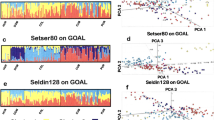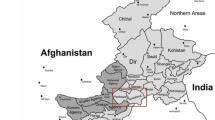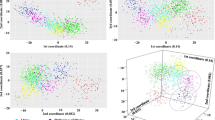Abstract
Population and geographic assignment are frequently undertaken using DNA sequences on the mitochondrial genome. Assignment to broad continental populations is common, although finer resolution to subpopulations can be less accurate due to shared genetic ancestry at a local level and members of different ancestral subpopulations cohabiting the same geographic area. This study reports on the accuracy of population and subpopulation assignment by using the sequence data obtained from the 3070 mitochondrial genomes and applying the K-nearest neighbors (KNN) algorithm. These data also included training samples used for continental and population assignment comprised of 1105 Europeans (including Austria, France, Germany, Spain, and England and Caucasian countries), 374 Africans (including North and East Africa and non-specific area (Pan-Africa)), and 1591 Asians (including Japan, Philippines, and Taiwan). Subpopulations included in this study were 1153 mitochondrial DNA (mtDNA) control region sequences from 12 subpopulations in Taiwan (including Han, Hakka, Ami, Atayal, Bunun, Paiwan, Puyuma, Rukai, Saisiyat, Tsou, Tao, and Pingpu). Additionally, control region sequence data from a further 50 samples, obtained from the Sigma Company, were included after they were amplified and sequenced. These additional 50 samples acted as the “testing samples” to verify the accuracy of the population. In this study, based on genetic distances as genetic metric, we used the KNN algorithm and the K-weighted-nearest neighbors (KWNN) algorithm weighted by genetic distance to classify individuals into continental populations, and subpopulations within the same continent. Accuracy results of ethnic inferences at the level of continental populations and of subpopulations among KNN and KWNN algorithms were obtained. The training sample set achieved an overall accuracy of 99 to 82% for assignment to their continental populations with K values from 1 to 101. Population assignment for subpopulations with K assignments from 1 to 5 reached an accuracy of 77 to 54%. Four out of 12 Taiwanese populations returned an accuracy of assignment of over 60%, Ami (66%), Atayal (67%), Saisiyat (66%), and Tao (80%). For the testing sample set, results of ethnic prediction for continental populations with recommended K values as 5, 10, and 35, based on results of the training sample set, achieved overall an accuracy of 100 to 94%. This study provided an accurate method in population assignment for not only continental populations but also subpopulations, which can be useful in forensic and anthropological studies.


Similar content being viewed by others
Data availability
Not applicable
Code availability
Not applicable
References
Kivisild T (2015) Maternal ancestry and population history from whole mitochondrial genomes. Investig Genet 6:3. https://doi.org/10.1186/s13323-015-0022-2
Irwin JA, Saunier JL, Strouss KM, Sturk KA, Diegoli TM, Just RS, Coble MD, Parson W, Parsons TJ (2007) Development and expansion of high-quality control region databases to improve forensic mtDNA evidence interpretation. Forensic Sci Int Genet 1(2):154–157. https://doi.org/10.1016/j.fsigen.2007.01.019
Budowle B, Allard MW, Wilson MR, Chakraborty R (2003) Forensics and mitochondrial DNA: applications, debates, and foundations. Annu Rev Genomics Hum Genet 4:119–141. https://doi.org/10.1146/annurev.genom.4.070802.110352
Pakendorf B, Stoneking M (2005) Mitochondrial DNA and human evolution. Annu Rev Genomics Hum Genet 6:165–183
Lee C, Măndoiu II, Nelson CE (2010) Inferring ethnicity from mitochondrial DNA sequence. BMC Proc 5:S11. https://doi.org/10.1186/1753-6561-5-S2-S11
Egeland T, Bøvelstad HM, Storvik GO, Salas A (2004) Inferring the most likely geographical origin of mtDNA sequence profiles. Ann Hum Genet 68(5):461–471. https://doi.org/10.1046/j.1529-8817.2004.00109.x
Torroni A, Schurr TG, Cabell MF, Brown MD, Neel JV, Larsen M, Smith DG, Vullo CM, Wallace DC (1993) Asian affinities and continental radiation of the four founding Native American mtDNAs. Am J Hum Genet 53(3):563–590
Chen YS, Torroni A, Excoffier L, Santachiara-Benerecetti AS, Wallace DC (1995) Analysis of mtDNA variation in African populations reveals the most ancient of all human continent-specific haplogroups. Am J Hum Genet 57(1):133–149
Torroni A, Huoponen K, Francalacci P, Petrozzi M, Morelli L, Scozzari R, Obinu D, Savontaus ML, Wallace DC (1996) Classification of european mtDNAs from an analysis of three European populations. Genetics 144(4):1835–1850
Umetsu K, Yuasa I (2005) Recent progress in mitochondrial DNA analysis. Legal Med 7(4):259–262. https://doi.org/10.1016/j.legalmed.2005.01.005
Emery LS, Magnaye KM, Bigham AW, Akey JM, Bamshad MJ (2015) Estimates of continental ancestry vary widely among individuals with the same mtDNA haplogroup. Am J Hum Genet 96(2):183–193. https://doi.org/10.1016/j.ajhg.2014.12.015
Yamamoto K, Sakaue S, Matsuda K, Murakami Y, Kamatani Y, Ozono K, Momozawa Y, Okada Y (2020) Genetic and phenotypic landscape of the mitochondrial genome in the Japanese population. Commun Biol 3(1):1–11. https://doi.org/10.1038/s42003-020-0812-9
Lee JC, Ph D, Tsai L et al (2011) The distribution of mitochondrial D-loop sequence variations in Taiwan populations. FSJ 10(1):29–38
Kimura M (2020) The neutral theory and molecular evolution. In: My Thoughts on Biological Evolution. Evolutionary Studies. Springer, Singapore. https://doi.org/10.1007/978-981-15-6165-8_8
Nei M (1972) Genetic distance between populations. Am Nat 106:283–292
Nei M (1978) The theory of genetic distance and evolution of human races. Jap J Human Genet 23:341–369. https://doi.org/10.1007/BF01908190
Saitou N, Nei M (1987) The neighbor-joining method: a new method for reconstructing phylogenetic trees. Mol Biol Evol 4(4):406–425. https://doi.org/10.1093/oxfordjournals.molbev.a040454
Tajima A, Sun CS, Pan IH, Ishida T, Saitou N, Horai S (2003) Mitochondrial DNA polymorphisms in nine aboriginal groups of Taiwan: Implications for the population history of aboriginal Taiwanese. Hum Genet 113(1):24–33. https://doi.org/10.1007/s00439-003-0945-1
Libbrecht M, Noble W (2015) Machine learning applications in genetics and genomics. Nat Rev Genet 16:321–332. https://doi.org/10.1038/nrg3920
Schrider DR, Kern AD (2018) Supervised machine learning for population genetics: a new paradigm. Trends Genet 34(4):301–312. https://doi.org/10.1016/j.tig.2017.12.005
Suguna N, Thanushkodi K (2010) An improved k-nearest neighbor classification using genetic algorithm. IJCSI 7(4):814–1694
Duda RO, Hart PE, Stork DG (2000) Pattern Classification, 2nd edn. Wiley-Interscience, New York
van Oven M, Kayser M (2009) Updated comprehensive phylogenetic tree of global human mitochondrial DNA variation. Hum Mutat 30(2):E386–E394. http://www.phylotree.org. https://doi.org/10.1002/humu.20921. Accessed 30 Jan 2019
Ko AMS, Chen CY, Fu Q, Delfin F, Li M, Chiu HL, Stoneking M, Ko YC (2014) Early austronesians: into and out of Taiwan. Am J Hum Genet 94(3):426–436. https://doi.org/10.1016/j.ajhg.2014.02.003
Bilal E, Rabadan R, Alexe G, Fuku N, Ueno H, Nishigaki Y, Fujita Y, Ito M, Arai Y, Hirose N, Ruckenstein A, Bhanot G, Tanaka M (2008) Mitochondrial DNA haplogroup D4a is a marker for extreme longevity in Japan. PLoS One 3(6):e2421. https://doi.org/10.1371/journal.pone.0002421
Delfin F, Min-Shan Ko A, Li M, Gunnarsdóttir ED, Tabbada KA, Salvador JM, Calacal GC, Sagum MS, Datar FA, Padilla SG, de Ungria MCA, Stoneking M (2014) Complete mtDNA genomes of Filipino ethnolinguistic groups: a melting pot of recent and ancient lineages in the Asia-Pacific region. Eur J Hum Genet 22(2):228–237. https://doi.org/10.1038/ejhg.2013.122
Behar DM, Harmant C, Manry J, van Oven M, Haak W, Martinez-Cruz B, Salaberria J, Oyharçabal B, Bauduer F, Comas D, Quintana-Murci L, Genographic Consortium (2012) The Basque paradigm: genetic evidence of a maternal continuity in the Franco-Cantabrian region since pre-neolithic times. Am J Hum Genet 90(3):486–493. https://doi.org/10.1016/j.ajhg.2012.01.002
Coble MD, Just RS, O’Callaghan JE, Letmanyi IH, Peterson CT, Irwin JA, Parsons TJ (2004) Single nucleotide polymorphisms over the entire mtDNA genome that increase the power of forensic testing in Caucasians. Int J Legal Med 118(3):137–146. https://doi.org/10.1007/s00414-004-0427-6
Behar DM, Villems R, Soodyall H, Blue-Smith J, Pereira L, Metspalu E, Scozzari R, Makkan H, Tzur S, Comas D, Bertranpetit J, Quintana-Murci L, Tyler-Smith C, Wells RS, Rosset S, Genographic Consortium (2008) The dawn of human matrilineal diversity. Am J Hum Genet 82(5):1130–1140. https://doi.org/10.1016/j.ajhg.2008.04.002
Soares P, Alshamali F, Pereira JB, Fernandes V, Silva NM, Afonso C, Costa MD, Musilova E, Macaulay V, Richards MB, Cerny V, Pereira L (2012) The expansion of mtDNA haplogroup L3 within and out of Africa. Mol Biol Evol 29(3):915–927. https://doi.org/10.1093/molbev/msr245
Yang IS, Lee HY, Yang WI, Shin KJ (2013) mtDNAprofiler: a Web application for the nomenclature and comparison of human mitochondrial DNA sequences. J Forensic Sci 58:972–980. https://doi.org/10.1111/1556-4029.12139
Edgar RC (2004) MUSCLE: a multiple sequence alignment method with reduced time and space complexity. BMC Bioinformatics 5:113. https://doi.org/10.1186/1471-2105-5-113
Felsenstein J (1989) PHYLIP - Phylogeny Inference Package (Version 3.2). Cladistics. 5:164–166
Polychronopoulos V (2012) Appying machine learning methods to a mitochondrial DNA dataset to guess ethnicity. https://users.soe.ucsc.edu/~vassilis/projects/CMPS242_ProjectReport_Polychronopoulos.pdf Accessed 1 September 2020
Qu Y, Tran D, Ma W (2019) Deep learning approach to biogeographical ancestry inference. Procedia Comput Sci 159:552–561. https://doi.org/10.1016/j.procs.2019.09.210
Acknowledgements
We thank the Ministry of Science and Technology of Taiwan who supported the study with a grant MOST 107-2320-B-002-045-MY3 and the Department of Medical Research at the National Taiwan University Hospital (Taipei, Taiwan) for the assistance of capillary electrophoresis.
Funding
The Ministry of Science and Technology of Taiwan supported the study with a grant (MOST 107-2320-B-002-045-MY3).
Author information
Authors and Affiliations
Contributions
All authors contributed to generate the conception and design of the study. Fu-Chi Yang and Bill Tseng conducted the creation of software; Fu-Chi Yang, Chun-Yen Lin and Yu-Jen Yu carried data collection, analysis and wet lab; Fu-Chi Yang, Adrian Linacre and James Chun-I Lee drafted the manuscript.
Corresponding author
Ethics declarations
Ethics approval
This study was approved by Research Ethics Committee A National Taiwan University Hospital (No. 201910047W).
Consent to participate
Not applicable
Consent for publication
Not applicable
Conflict of interest
The authors declare no conflicts of interest.
Additional information
Publisher’s note
Springer Nature remains neutral with regard to jurisdictional claims in published maps and institutional affiliations.
Supplementary Information
ESM 1
(XLSX 105 kb)
Rights and permissions
About this article
Cite this article
Yang, FC., Tseng, B., Lin, CY. et al. Population inference based on mitochondrial DNA control region data by the nearest neighbors algorithm. Int J Legal Med 135, 1191–1199 (2021). https://doi.org/10.1007/s00414-021-02520-3
Received:
Accepted:
Published:
Issue Date:
DOI: https://doi.org/10.1007/s00414-021-02520-3




